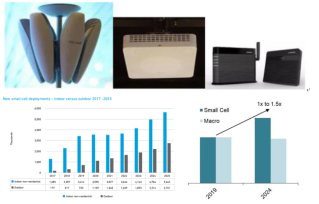In the 5G era, indoor scenarios have become the mainstream, with over 80% of data traffic expected to occur indoors. For vertical industry applications, indoor scenarios such as VR/AR and 4K/8K services are also increasing, posing new demands on operators' indoor coverage capabilities. Against this backdrop, 5G small cells that are easy to deploy, maintain, low-power, and cost-effective are increasingly attracting industry attention, with the potential for explosive growth in small cell deployment.
The global small cell equipment shipment volume is projected to have an average annual compound growth rate of over 100% in the next five years, reaching 117%. Wei Le Ping, the Executive Deputy Director of the Communication Science and Technology Committee of the Ministry of Industry and Information Technology and the Director of the Science and Technology Committee of China Telecom, previously stated that the 5G era will bring significant opportunities for small cells, with the number of 5G small cells in the Chinese market expected to reach tens of millions.
It is no exaggeration to say that small cells have become an essential part of 5G networks. In a sense, the deployment progress of small cells is one of the key factors determining the success of 5G commercialization, and it will redefine the competitive landscape of telecommunications equipment vendors and operators.

During the 3G/4G era, operators had already begun deploying small cells. However, indoor coverage at that time still relied mainly on outdoor-to-indoor coverage and traditional DAS systems, with small cells primarily used for network expansion and coverage assurance in key areas. In the 5G era, however, as frequencies continue to rise, signals struggle to penetrate walls or buildings, rendering the outdoor-to-indoor approach ineffective. Traditional DAS systems also have drawbacks such as difficulty in reusing existing infrastructure, high upgrade costs, and complex deployment. As a result, 5G small cells, with their advantages of high capacity, low cost, and simple deployment, have begun to emerge as an important means for indoor network digitalization. SDSX will also assist major communication companies in improving the construction of 5G small cells. With the growing domestic demand for domestic chips, SDSX will ride the wave and implement the strategy of chip localization, expand into domestic and international markets, and promote international services.
In addition to the basic needs of indoor network coverage, the vertical industry market also expects high network performance, high maintenance efficiency, and diversified services. Traditional DAS systems face challenges such as difficulty in detecting faults, locating issues, monitoring, and achieving precise coverage, making it hard to meet the diverse needs of industry users. Meanwhile, macro cells are relatively expensive and less flexible, also failing to meet user demands.
At this juncture, small cells become crucial.
Previous article: What is a Small Cell
Next article: [Industry Selection]